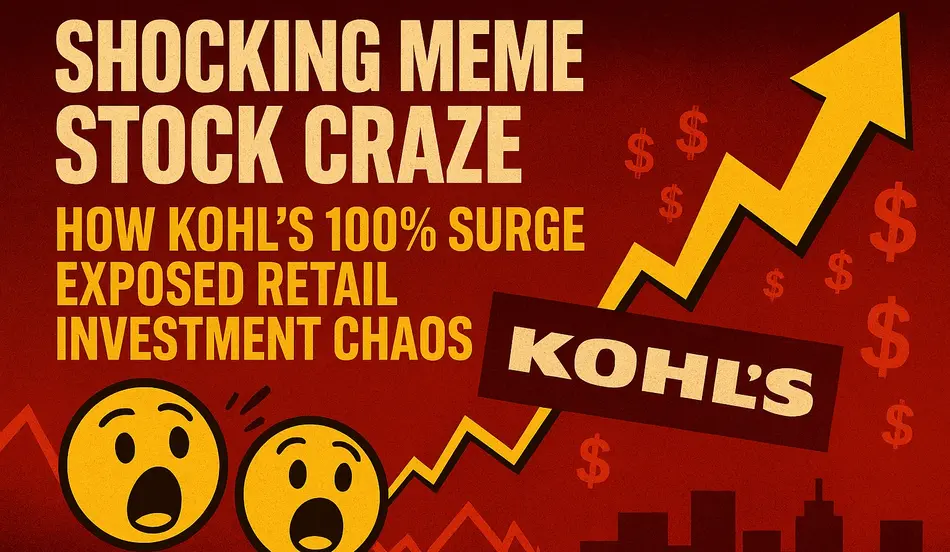Introduction: The Explosive Meme Stock Craze That’s Shaking Wall Street
The meme stock craze has returned with a vengeance this summer, with Kohl’s becoming the latest victim of this volatile investment phenomenon. This meme stock craze represents a dangerous trend where retail investors band together on social media platforms to manipulate stock prices, often targeting heavily shorted companies regardless of their fundamental business performance. The meme stock craze has transformed what should be a rational investment market into a chaotic battleground between individual investors and institutional money.
The meme stock craze surrounding Kohl’s saw the legacy department store’s stock soar by 100% on July 22nd, despite the company reporting what analysts described as “just okay” quarterly results. This meme stock craze demonstrates how social media momentum can completely disconnect stock prices from business fundamentals, creating a dangerous environment where casual investors can lose significant money while trying to “stick it to the smart money.”
The Anatomy of the Meme Stock Craze
Understanding the Short Squeeze Phenomenon
The meme stock craze operates through a complex mechanism known as a short squeeze, which creates a perfect storm for explosive price movements. When investors short a stock, they borrow shares from a broker and immediately sell them on the open market, hoping to buy them back later at a lower price. The meme stock craze exploits this strategy by driving prices higher, forcing short sellers to cover their positions at significant losses.
The meme stock craze creates an intense feedback loop where rising prices force more short sellers to buy back shares, which further drives up the price. This meme stock craze mechanism can result in exponential losses for short sellers, as demonstrated by the GameStop phenomenon where hedge funds lost billions of dollars. The meme stock craze has become particularly dangerous because it’s driven by social media trends rather than fundamental analysis, making it nearly impossible to predict or control.
The Social Media Amplification Effect
The meme stock craze is fundamentally a social media phenomenon, with platforms like Reddit’s WallStreetBets serving as the primary catalysts for these coordinated buying campaigns. The meme stock craze thrives on the power of collective action, where thousands of individual investors can coordinate their efforts to move markets in ways that were previously impossible. This meme stock craze represents a democratization of market manipulation, where retail investors can challenge institutional power through sheer numbers.
The meme stock craze has been particularly effective against well-known household brands like Kohl’s, GameStop, and AMC because these companies have built-in recognition that makes them easier targets for social media campaigns. The meme stock craze demonstrates how brand recognition can become a liability in the age of social media investing, as familiar names attract more attention from casual investors looking to participate in the latest trend.
Kohl’s and the Meme Stock Craze
The Perfect Storm for Kohl’s
The meme stock craze that engulfed Kohl’s was the result of several converging factors that created ideal conditions for a short squeeze. Going into July 22nd, approximately 50% of the trading activity around Kohl’s involved investors shorting the stock, creating a massive short interest that made the company vulnerable to a coordinated buying campaign. The meme stock craze targeting Kohl’s was particularly effective because the company is a well-recognized household name, making it easier to generate interest and excitement among retail investors.
The meme stock craze surrounding Kohl’s occurred despite the company’s poor fundamental performance, with sales declining by 18.5% between 2019 and 2024. The meme stock craze demonstrates how social media momentum can completely override traditional investment analysis, creating situations where stock prices bear no relationship to business performance. This meme stock craze phenomenon has made it increasingly difficult for companies to manage their stock prices based on actual business results.
The Aftermath and Corporate Impact
The meme stock craze had immediate consequences for Kohl’s, with the company’s chief marketing officer Kristy Raymond selling 26,500 shares worth approximately half a million dollars during the price surge. While the company claimed this was part of a pre-established trading plan, the meme stock craze created an environment where corporate insiders could benefit from artificially inflated prices. The meme stock craze has raised questions about the ethics of insider trading during periods of market manipulation.
The meme stock craze has also created significant challenges for Kohl’s management, as the company struggles to focus on day-to-day operations while dealing with wild stock price swings. The meme stock craze has become a distraction from the company’s core business challenges, including declining sales, shrinking customer base, and the need for strategic transformation. This meme stock craze phenomenon highlights how market manipulation can interfere with legitimate business operations.
The Broader Impact of the Meme Stock Craze
The Domino Effect Across Retail
The meme stock craze didn’t stop with Kohl’s, as other retail companies quickly became targets of similar campaigns. Following the Kohl’s surge, companies like GoPro, American Eagle, and Krispy Kreme experienced sharp swings in their stock prices as Reddit users coordinated short squeeze campaigns. The meme stock craze has created a pattern where any heavily shorted company with a recognizable brand becomes a potential target for social media-driven manipulation.
The meme stock craze has been particularly damaging to the retail sector, which was already struggling with fundamental challenges including declining foot traffic, e-commerce competition, and changing consumer preferences. The meme stock craze has added another layer of volatility to an already unstable industry, making it difficult for companies to plan for the future or attract long-term investors. This meme stock craze phenomenon has created a situation where retail stocks are valued based on social media sentiment rather than business performance.
The Casualty of Traditional Investing
The meme stock craze represents a fundamental challenge to traditional investment principles, where stock prices were supposed to reflect the underlying value of businesses. The meme stock craze has created an environment where casual investors can move markets through coordinated social media campaigns, regardless of whether they understand the companies they’re investing in. This meme stock craze phenomenon has made it increasingly difficult for fundamental analysts to provide accurate valuations or investment advice.
The meme stock craze has also created significant risks for retail investors who may not understand the mechanics of short squeezes or the temporary nature of these price movements. The meme stock craze often results in significant losses for latecomers who buy at inflated prices, as demonstrated by the Bed Bath & Beyond bankruptcy where many retail investors lost money after buying shares at artificially high levels. This meme stock craze phenomenon highlights the dangers of investing based on social media trends rather than fundamental analysis.
Hiring Finance Pros Who Get the Market Hype?
Post your roles in analysis, research, and investment strategy—find talent who can navigate both balance sheets and viral trends.
Post a Job Now →The Future of the Meme Stock Craze
Predicting the Next Target
The meme stock craze has made it increasingly difficult to predict which companies will become the next targets of social media-driven manipulation. The meme stock craze typically targets companies that have household names, some nostalgia factor, and are heavily shorted, but the specific timing and intensity of these campaigns is nearly impossible to predict. This meme stock craze unpredictability has created a challenging environment for both investors and companies.
The meme stock craze has shown that any company trading cheaply with a recognizable brand could potentially become a target, regardless of their business fundamentals. The meme stock craze has created a situation where companies must consider their vulnerability to social media manipulation as part of their risk management strategy. This meme stock craze phenomenon has added a new dimension to corporate governance and investor relations.
Regulatory and Market Structure Implications
The meme stock craze has raised significant questions about market structure and the need for regulatory intervention. The meme stock craze has demonstrated how social media platforms can be used to coordinate market manipulation on a scale that was previously impossible. This meme stock craze phenomenon has prompted calls for increased oversight of social media-driven trading and potential restrictions on coordinated buying campaigns.
The meme stock craze has also highlighted the need for better investor education about the risks of social media-driven investing. The meme stock craze has created a generation of investors who may not understand the fundamental principles of investing or the risks associated with market manipulation. This meme stock craze phenomenon has created an urgent need for financial literacy programs that address the unique challenges of social media investing.
Frequently Asked Questions About the Meme Stock Craze
What is the meme stock craze and how does it work?
The meme stock craze refers to coordinated social media campaigns that drive up stock prices through short squeezes, regardless of business fundamentals. The meme stock craze works by targeting heavily shorted companies and using collective buying power to force short sellers to cover their positions at significant losses.
How has the meme stock craze affected companies like Kohl’s?
The meme stock craze has caused Kohl’s stock to surge 100% despite poor quarterly results, creating artificial price inflation that distracts from business fundamentals. The meme stock craze has made it difficult for companies to manage their stock prices based on actual performance and has created opportunities for insiders to profit from manipulated prices.
What are the main risks of the meme stock craze?
The meme stock craze creates significant risks for retail investors who may lose money buying at inflated prices, as demonstrated by Bed Bath & Beyond’s bankruptcy. The meme stock craze also distracts companies from core business operations and creates market volatility that can harm long-term investors and market stability.
Will the meme stock craze continue to affect the market?
The meme stock craze is likely to continue as long as social media platforms enable coordinated trading campaigns and retail investors seek to challenge institutional power. The meme stock craze represents a fundamental shift in market dynamics that requires new approaches to regulation and investor education.
Hiring? Post jobs for free with WhatJobs – Find opportunities in financial analysis, market research, and investment management as companies adapt to the meme stock craze and seek professionals who understand both traditional fundamentals and social media-driven market dynamics.
Need Career Advice? – Explore careers in fintech, social media analysis, and regulatory compliance that help navigate the meme stock craze and protect investors from market manipulation while maintaining market integrity.
The meme stock craze represents one of the most significant challenges facing modern financial markets, requiring coordinated response from regulators, companies, and investors. As the meme stock craze continues to evolve, the need for better understanding, regulation, and investor protection has never been more critical for maintaining market stability and protecting individual investors from potentially devastating losses.




